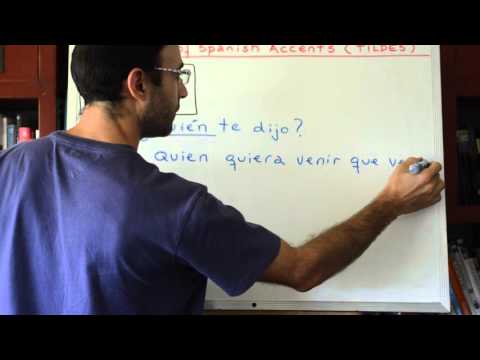Spanish accents – Rule Nbr. 3
The use of Spanish accents is explained very thoroughly through these 4 rules:
1) “tildes” for words that are “agudas“, “graves o llanas” and “esdrújulas” (Lesson 294)
2) “tildes” for “hiatos” (Lesson 297)
3) “tildes” for question words
4) Tildes to differentiate between monosyllables that are spelled the same, but have different meaning
Technically speaking, in Spanish when we say “acento” we don’t necessarily mean the “tilde”, rather the syllable of a word that is accentuated. To refer to that short line that we sometimes place on a vowel, we say “tilde” (even-though many native Spanish speakers incorrectly call it “acento”).
Our 3rd Rule of Spanish accents indicates that whenever there is a question word involved in either an interrogation or exclamation, it should carry a “tilde”. However, when those same Question Words are found in a none interrogative sentence, they wont carry a “tilde”.
If you still haven’t learnt the previous Rules of Spanish accents or “tildes”, I recommend you to refer to the lessons below:
- Lesson 294: Spanish accents rules (tildes) – Rule 1
- Lesson 295: Spanish diphthongs & hiatus – Part1
- Lesson 296: Spanish diphthongs & hiatus – Part 2
- Lesson 297: Tilde Spanish – Rule Nbr. 2 of Spanish accents
Examples of 3rd Rule of Spanish Accents:
- ¿Quién lo dijo? – Who said it?
- Quien lo haya dicho tiene que hablar – Whoever said it has to speak.
- ¿Cuándo comeremos? – When will we eat?
- Avísame cuando llegue la hora – Tell me when the moment/time arrives.
- ¿Qué haces? – What are you doing?
- ¡Qué desastre! – What a disaster!
- Dijo que sí – He said yes
- ¿Cuánto dinero tienes? – How much money do you have?
- ¡Cuánto dinero! – How much money!
- Cuanto más, mejor – The more, the better.
You can find a full list of all the video lessons by clicking on the List of Lessons tab on the Main Menu.
To enlarge the video-screen to full-size, click on the right icon on the lower right corner of the video.













